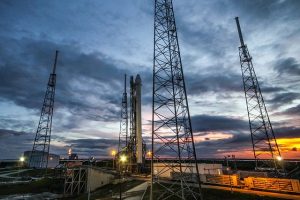 Since announcing the Starlink project in 2015, many people have wondered just how fast SpaceX’s new internet service will be. Starlink doesn’t use a ground connection to provide internet service. Rather, it’s called “Starlink” because it consists of a large network of low Earth orbit (LEO) satellites that wireless beam internet service to consumers throughout the world. Other satellite-based internet services have generally provided slow speeds and sluggish performance, leaving many people skeptical of SpaceX’s new internet service. While SpaceX is still in the early stages of rolling out the service, though, we now have some data regarding Starlink’s download speeds.
Since announcing the Starlink project in 2015, many people have wondered just how fast SpaceX’s new internet service will be. Starlink doesn’t use a ground connection to provide internet service. Rather, it’s called “Starlink” because it consists of a large network of low Earth orbit (LEO) satellites that wireless beam internet service to consumers throughout the world. Other satellite-based internet services have generally provided slow speeds and sluggish performance, leaving many people skeptical of SpaceX’s new internet service. While SpaceX is still in the early stages of rolling out the service, though, we now have some data regarding Starlink’s download speeds.
How Fast Is Starlink?
Starlink is currently in beta testing, so we really won’t know how fast it will truly be until SpaceX has completed the project. With that said, an article published by Ars Technica revealed that beta testers are currently experiencing download speeds of 11Mbps to 60Mbps. According to Ars Technica, the download speeds were discovered by Reddit users who scoured data from the web-based speed testing tool at speedtest.net. The Reddit users found that Starlink users were experiencing download speeds of up to 60Mbps.
While 60Mbps isn’t particularly fast, it’s still faster than the national average. Research shows that the average download speed in the United States is a little over 50Mbps. Assuming all its users achieved 60Mbps, that’s a fairly substantial difference. It’s important to note, though, that SpaceX says its satellite-based internet service will eventually provide download speeds in the realm of “gigabytes.” Therefore, Starlink users will likely achieve much faster download speeds in the months and years to come.
How Starlink Works
Starlink is an internet service being developed by SpaceX. Once complete, it will use thousands of LEO satellites to wirelessly project internet service to the service’s customers. Starlink is distinguished from other satellite-based internet services by specifically using LEO. Other satellite-based internet services involve a higher orbit, meaning there’s a greater distance between the satellites and the customer for whom they provide internet service. With a longer distance, customers experience slower download speeds. SpaceX hopes to solve this problem by flying its satellites in LEO, resulting in a shorter distance to its customers.
SpaceX is currently launching the Starlink satellites in batches of 60. Thus far, the U.S. Federal Aviation Administration (FAA) has approved SpaceX for the deployment of 12,000 Starlink satellites. If all goes as planned, though, SpaceX says its network may consist of up to 42,000 satellites, each of which will beam internet service to its Starlink customers.



